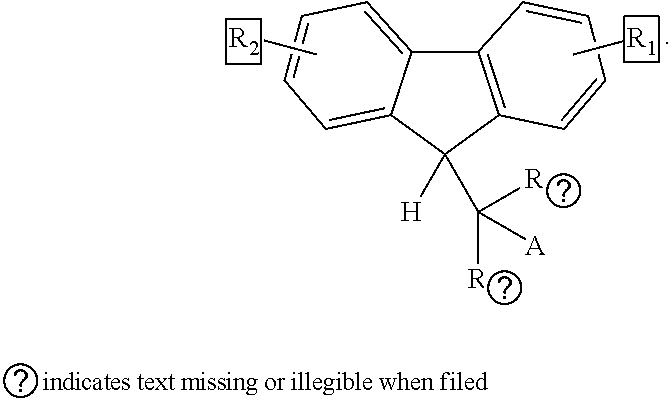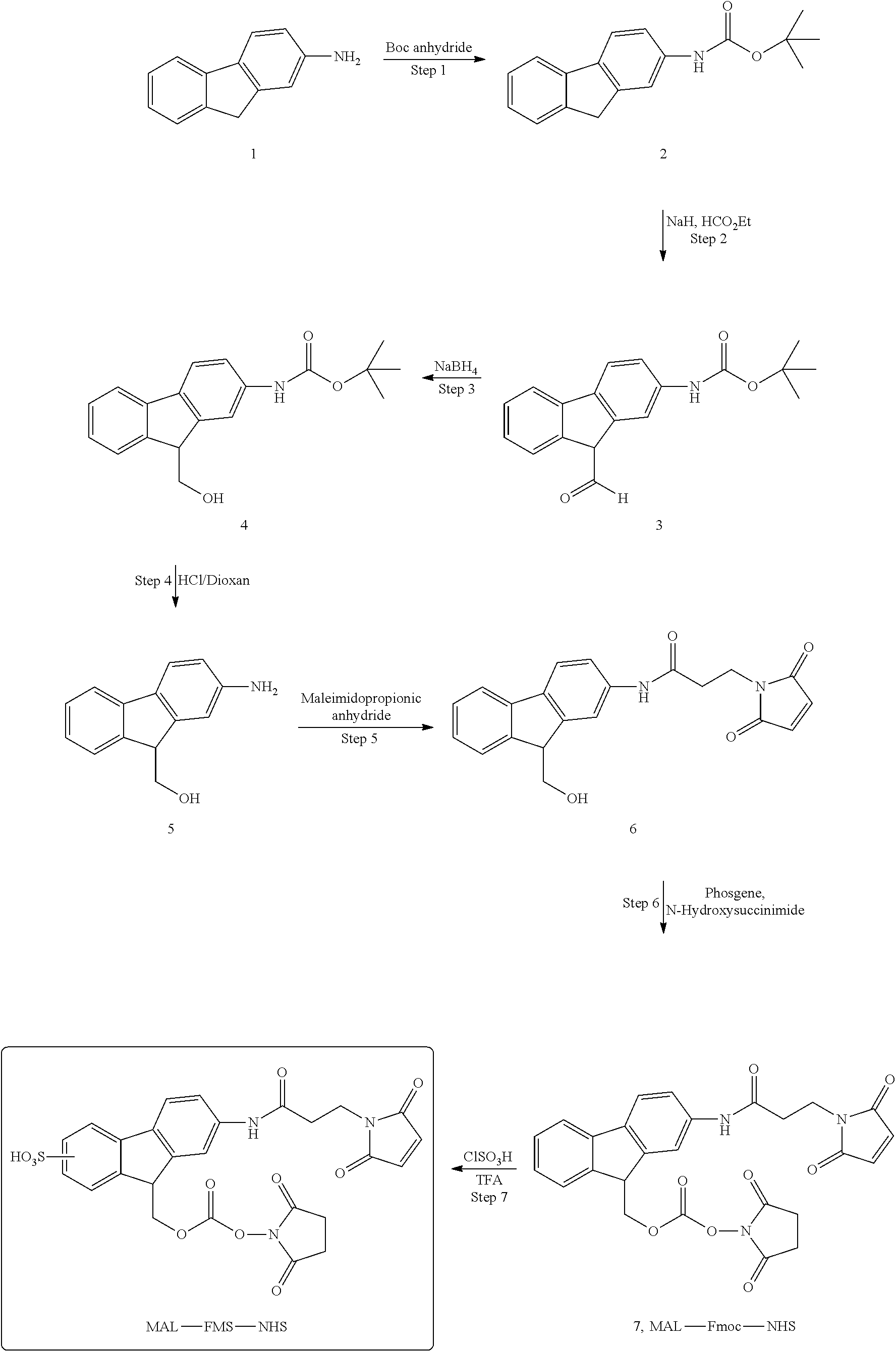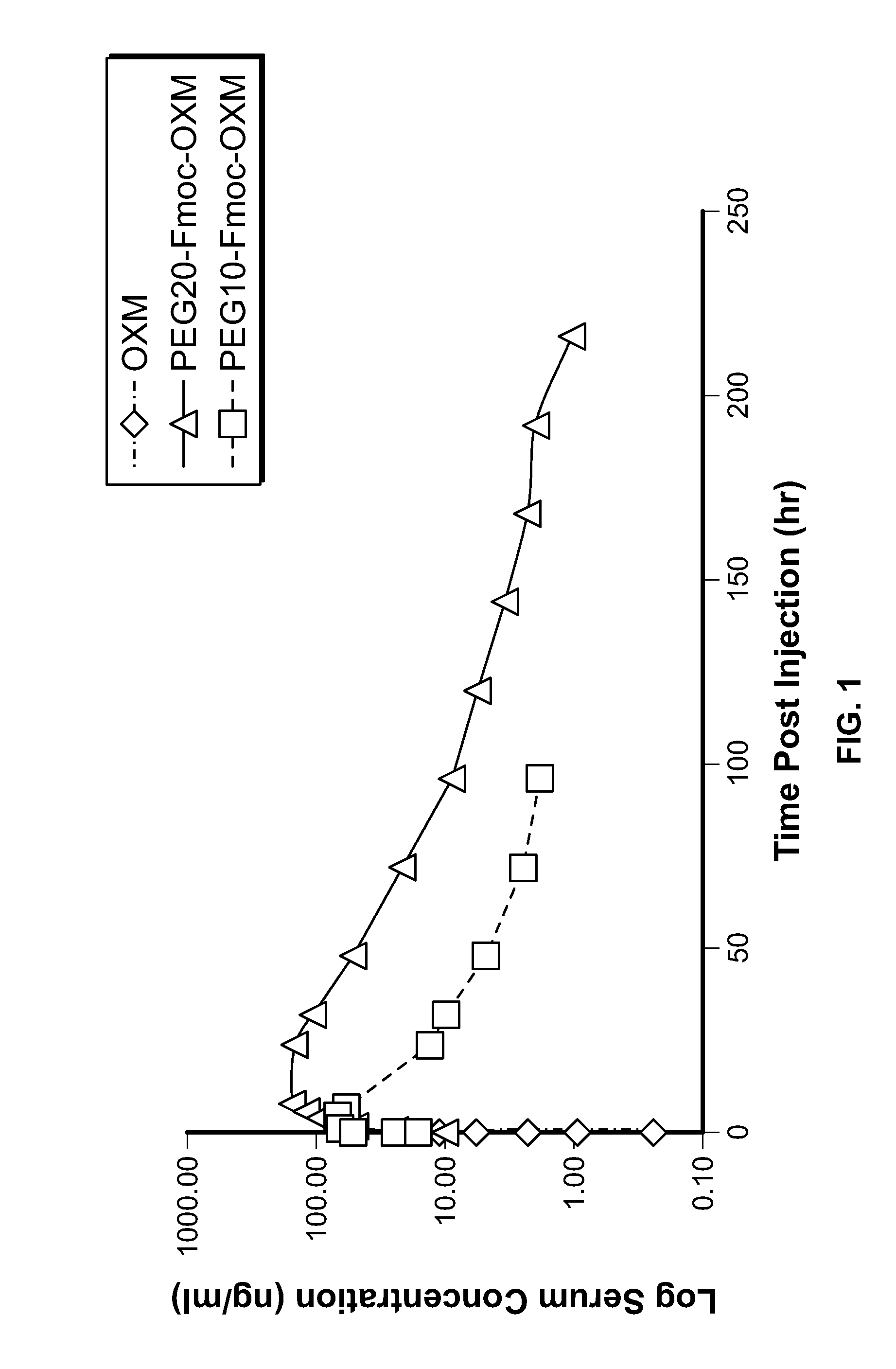Long-acting glp-1/glucagon receptor agonists
a glucagon receptor and long-acting technology, applied in the direction of peptide/protein ingredients, extracellular fluid disorder, metabolic disorder, etc., can solve the problems of preventing the development of many otherwise promising drug candidates, affecting the development of drug candidates, and causing considerable discomfort to subjects, etc., to achieve the effect of reducing insulin resistan
- Summary
- Abstract
- Description
- Claims
- Application Information
AI Technical Summary
Benefits of technology
Problems solved by technology
Method used
Image
Examples
example 1
Synthesis and Characterization of PEG-Fmoc-OXM
[0213]OXM peptide was synthesized by the solid phase method employing the Fmoc-strategy throughout the peptide chain assembly. The peptide was purified by preparative HPLC using Phenomenex Luna C18 (250×30 mm) column by applying gradient between solution A (0.1% TFA+H2O) and B (0.1% TFA+MeCN). Peptide purity was above 95%, the molecular weight was 4449 Da (measured by MALDI). Conjugation of OXM peptide to PEG40-SH through Fmoc linker was performed in the presence of NaHCO3. The reaction mixture was stirred for 24 h at RT followed by filtration and purification by preparative HPLC (Jupiter C5). Conjugate molecular weight was analyzed by MALDI and OXM peptide content was analyzed by AAA. The average OXM peptide content was 189 μg OXM per 1 mg PEG10-Fmoc-OXM conjugate 132.4 μg OXM per 1 mg PEG20-Fmoc-OXM conjugate, 61.7 μg OXM per 1 mg PEG40-Fmoc-OXM conjugate and 40 μg OXM per 1 mg PEG40-FMS-OXM conjugate.
example 2
Pharmacokinetic Profile of PEG10-Fmoc-OXM, PEG20-Fmoc-OXM and PEG40-Fmoc-OXM Compared to Native OXM
[0214]The pharmacokinetic profile of OXM compared to PEG10-Fmoc-OXM and PEG20-Fmoc-OXM was evaluated in male Wistar rats. Animals were administrated with a single SC injection of native OXM (278 μg / kg peptide), PEG10-Fmoc-OXM (278 m / kg peptide content) or PEG20-Fmoc-OXM (278 μg / kg peptide content). The serum concentration of the compound at indicated time intervals was measured (commercial ELISA, PK profile shown in FIG. 1 and conventional noncompartmental PK parameters are summarized in Table 3). Reversible pegylation of OXM conjugated to both PEG10 and PEG20 resulted in prolongation of the half-life of native OXM (0.15 hr for native OXM; 16.16 hr for PEG10-Fmoc-OXM and 27.38 hr for PEG20-Fmoc-OXM). Exposure as, reflected by the AUC parameter, was increased by about ˜450-fold for PEG10-Fmoc-OXM and about ˜2210 for PEG20-Fmoc-OXM. Thus, reversible conjugation of OXM to PEG20 resulted i...
example 3
Induction of cAMP by OXM and Reversible Pegylated OXM
[0215]In order to assess the in vitro activity of the OXM compared to PEG40-Fmoc-OXM, and PEG40-EMCS-OXM (non-reversible pegylated OXM), CHO-K1 cells over-expressing GLP-1 receptor were incubated with escalating concentrations of the different compound followed by cAMP quantitation. Native OXM demonstrated improved activity compared to PEG40-Fmoc-OXM and PEG40-EMCS-OXM which had comparable in-vitro activity (EC50 of 2.53×10−9, 2.07×10−6 and 5.87×10−7 for OXM, PEG40-EMCS-OXM and PEG40-Fmoc-OXM respectively, FIG. 3). Importantly, OXM pegylation didn't abrogate completely the GLP-1 receptor activation induced by OXM. In addition, while incubation of OXM in serum resulted in reduced activity, probably due partial proteolysis of the peptide, comparable activities in the present and absence of rat serum were obtained for PEG40-Fmoc-OXM and PEG40-EMCS-OXM, suggesting that pegylation masks potential proteolysis sites on OXM.
PUM
| Property | Measurement | Unit |
|---|---|---|
| Composition | aaaaa | aaaaa |
| Flexibility | aaaaa | aaaaa |
| Area | aaaaa | aaaaa |
Abstract
Description
Claims
Application Information
 Login to View More
Login to View More - R&D
- Intellectual Property
- Life Sciences
- Materials
- Tech Scout
- Unparalleled Data Quality
- Higher Quality Content
- 60% Fewer Hallucinations
Browse by: Latest US Patents, China's latest patents, Technical Efficacy Thesaurus, Application Domain, Technology Topic, Popular Technical Reports.
© 2025 PatSnap. All rights reserved.Legal|Privacy policy|Modern Slavery Act Transparency Statement|Sitemap|About US| Contact US: help@patsnap.com



